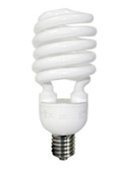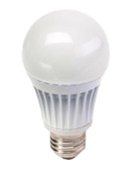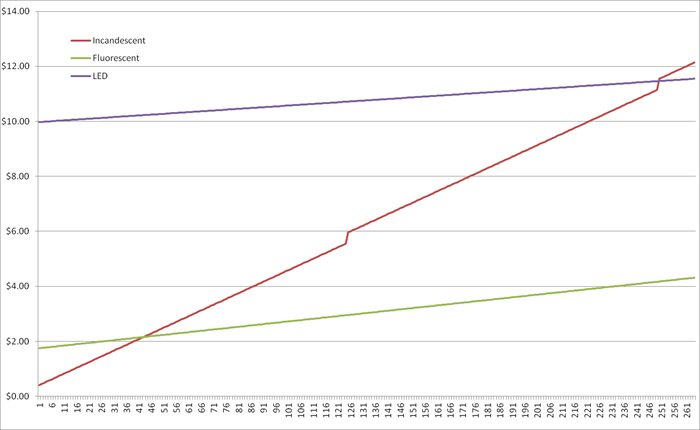Should I upgrade my light bulbs to LED
Posted on Feb 13, 2009 by
Paul WhiteBefore you read, please be aware that much of this information may be out of date due to the rapid advances in technology. I last updated the charts and info on 4/16/2012
The main reason I decided to do the math on these household upgrades, was because part of Obama's plan is to do things like replace light bulbs in government buildings to help save on energy costs. At first I was skeptical. But then I decided to research the options for myself. I was surprised with how much this upgrade can save me.
The upgrade I am talking about is replacing Incandescent light bulbs with the newer Fluorescent Bulbs or the LED Bulbs. The problem is like most Americans when I am Lowes or Home Depot getting replacement bulbs, I usually am focused on what this purchase is going to cost me today, rather than focusing on the long term savings. After all a light bulb only costs 80 cents or so.
The Lighting Options
 Incandescent Bulbs
Incandescent Bulbs
These bulbs have been around since the beginning. They provide plenty of light and are cheap to purchase. They work by running a current across a filament that emits light as it gets hot. They can be very bright, but they also generate lots of heat. Its estimated that 98 % of the energy they consume is converted into Heat. If you live in colder climates this heat might not be a bad thing, but during the summer months your Air Conditioner will be working over time to help remove the heat these bulbs generate.
 Fluorescent Bulbs
Fluorescent Bulbs
These Bulbs used to be very expensive. We most frequently associate these to what is installed into office buildings and schools. The long 48" glass tubes, that use high voltage to excite gas within the tube to give off light. These are much more efficient than Incandescent bulbs, but they still create some heat, and until recently they have not been available in more compact forms that more closely resemble incadescent bulbs in their shape. Their cost is still higher than regular light bulbs ( about 3-5 times as much ), but they use about 1/4 the energy, and convert much less of that energy into heat.
 LED Bulbs
LED Bulbs
LEDs have been around for a long time, but within the past decade or so, newer more powerful LEDs have been developed that are much brighter than the older ones. LEDs also run on lower voltages ( 5 Volts or less sometimes ), and they generate almost no heat. The downside to LEDs is their light is more directional, and they don't make very much light, with the exception of newer high output LEDs. In order to make a brighter LED you have to crame many LEDS into a single package. These packages sometimes have over 50 LEDs. Also since LEDs can't run on a home's 120 Volt AC. A transformer has to step the voltage down and convert it into DC rather than AC. These cost 10x as much as regular light bulbs, Though they burn 1/20 of the power.
Calculating the Cost Savings
Since most people in the USA have a Home Depot close by I will use them as the source for our bulbs. Pricing will come off their website. Also considering that the wattage rating of 60 watt LED bulbs are so close to that of the Incandescent bulbs we are going to use the 40 watt LED bulbs for our data. The thought behind this is we are going to buy the cheapest bulb that will fit our socket for each category.
Incandescent Bulb Properties
Philips 60 Watt Household Bulb ( 4 Pack ) from
Home Depot
Life: 1000 hours
Price Per Pack: $1.47
Price per Bulb: $0.37
Power Consumption: 60 watts
Light Output: 860 Lumens
Flourescent Bulb Properties
EcoSmart 14 watt (60 watt equivalent ) Soft White CFL Light Bulb from
Home Depot
Life: 10000 hours
Price Per Pack: $6.97
Price Per Bulb: $1.74
Power Consumption: 14 watts
Light Output: 900 Lumens
LED Bulb Properties
EcoSmart A19 8.6 Watt ( 40 Watt Equivalent ) LED Light Bulb From
Home Depot
Life: 50000 hours
Price Per Pack: $9.97
Price Per Bulb: $9.97
Power Consumption: 8.6 watts
Light Output: 430 Lumens.
Our Light Bulbs Compared
For the following charts, I am going to use our household's electric rates, and usage habits. In my office I have a lamp that is used 8 hours per day. Our Electricity costs 8.7 cents per KWH.
Daily cost of use
The equation to calculate the daily cost for each bulb is
( Watts x Hours ) / 1000 = KWH x KWH rate = Daily Cost
Bulb Type
| Watts
| x Hours
| KWH rate
| Daily Cost
|
Incandescent
| 60
| 8
| $0.087
| $0.04176
|
Fluorescent
| 14
| 8
| $0.087
| $0.00974
|
LED
| 8.6
| 8
| $0.087
| $0.00598
|
We also want our chart to show when our bulbs go out ( assuming they last their advertised lifespan )
Incandescent bulbs replaced every 1000 hours ( 125 days )
Fluorescent bulbs replaced every 10000 hours ( 1250 days )
LED bulbs replaced every 50000 hours ( 6250 days )
On the chart below the blips represent the purchase of a new bulb.

As you can see the break even point of going from Incandescent Bulbs to Fluorescent Bulbs happens within the first month. Break even point of going from Incandescent to LED is about 250 days. But the biggest shocker is if you are already using Flourescent lighting there is little reason to upgrade to LED. It would take you 1726 days ( 4.7 years ) just to break even.

In the above graph you can see the break even points for upgrading from Incandescent to Fluorescent or LED
Please keep in mind these figure do not include cooling costs due to waste heat. Incandescent Bulbs actually have a much usage cost because of this heat, however we don't have the data on how many BTUs the bulbs generate to calculate the additional Air Conditioning costs. LED bulbs may also generate slightly less heat than fluorescent bulbs, which might shorten the number of days to hit the break even point.
Importance of calculating your KWH rates
Not everyone enjoys the cheap electric rates. Some states like California have much higher rates that are 2 - 3 x our rates. If you electric rate was 2x 8.7 cents / KWH, then this would cut the number of days to break even in half. So instead of 250 days to break even with a Incandescent to LED upgrade it would only take 125 days.
In my opinion LED bulbs still have a long ways to go before they will be cost effective for household lighting. I will definitely be upgrading all the bulbs in my house to the newer compact Fluorescents.
Another reason to upgrade from Incandescent bulbs is the fact that they convert 98% of their energy into heat. During the summer months, this means that your Air Conditioner will have to burn more electricity just to compensate for the heat your light bulbs make.
How much money will it save you in 1 year?
By upgrading a single Incandescent Bulb to a Compact Flourescent that you use for 8 hours per day, you will save about $11 in the first year.
How fast will upgrading a single Incandescent Bulb to a Compact Flourescent pay for itself?
This chart should help

The upgrade will pay for itself in about 43 days assuming the bulb is used for 8 / hours a day.
After a full year of running these bulbs for 8 hours / day. CFL are still the best value. What is even more shocking is that incandescents are still cheaper ( assuming they didn't burn out more than a few times during that year ). Keep in mind that these figures do not take into account the cost for additional cooling since 95% of the energy going into incandescent light bulbs is released in the form of heat.
So when does using LED bulbs or LED chips save money?
Specialty lighting used in commercial / industrial environments is one place where LED lights can save you a bundle. Traditional Halogen bulbs even though are cheap, consume 250 watts, and only last about 500 hours. Discharge bulbs might last 2000 hours but cost $100 per bulb. The new LED chips out are bright as a 250 watt halogen, last 50K hours, and only cost $40 / each. But before you run out and try to slap an LED bulb into you club lights, its important to realize that if your fixture was not designed to run on LEDs then you will have to heavily modify your fixtures to work with LEDs. This is often more expensive than buying new fixtures.
SummaryAt this point CFL are still the best bargain for home owners.
35377 Visitors
35377 Views
 WhiteSites Blog
WhiteSites Blog
 Incandescent Bulbs
Incandescent Bulbs Fluorescent Bulbs
Fluorescent Bulbs LED Bulbs
LED Bulbs


I feel the rate of return for LED bulbs is much lower than youre calculation even against CFL fluorescents. I figure about two and half years . Savings at 8hrs a day based on .10 cent/kilowatt is about $ 10.50per year. Plus the fact that you will burn trough about 8 CFL in the life span of the LED. If you use them somewhere were they will be turned on/off often like closet, stairwells etc. they burn out in about 2 months. LEDs I bought havent died yet under same conditions, but jury still out.The bulbs I bought were from Menards $ 24.89 on sale. I also read if used in close proxcimitry like desk lamps the high U.V. from CFL's are not good for youre eyes
.